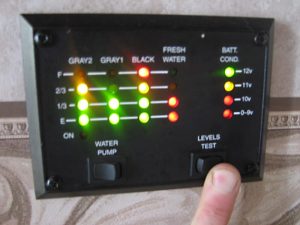CLEANING AND MAINTAINING HOLDING TANKS
 If you own an RV you have probably already come across this. And if you haven’t yet, consider yourself warned. It’s bound to happen eventually, even to the most experienced of us. You finish dumping your tanks but find when you go back into your RV that one or more tank levels are still reading “FULL”.
If you own an RV you have probably already come across this. And if you haven’t yet, consider yourself warned. It’s bound to happen eventually, even to the most experienced of us. You finish dumping your tanks but find when you go back into your RV that one or more tank levels are still reading “FULL”.
Before you start berating yourself for not correctly cleaning your waste water systems, you need to understand that this happens quite a bit. In fact, most RV users will encounter this if they spend any time in their RV. Luckily, fixing this problem can be very simple and inexpensive.
Let us start by taking a look at what is causing your sensors to misread, then we’ll look at a few solutions to this dilemma.
When it comes to your tank sensors, there are two reasons why the sensors are reading “Full”
- The sensor probes (found on the inside of the tank) have some kind of debris or waste stuck to them which results in them mis-reporting that the holding tank is full, even when it isn’t, or
- You a sensor (or multiple sensors) which are broken or malfunctioning and need to be replaced
Hopefully, it is only #1. This is the topic of this article.
HOW DO YOU CLEAN YOUR HOLDING TANK SENSORS?
There are three ways which you can attempt to clean your sensors and help restore the correct reading of tank levels. We have ordered them based on our preference, and in terms of their effectiveness and relative safety:
- An enzyme or bacteria solution
- Soap and soap solutions, or
- Using something stronger, such as drain opener
Below are brief descriptions of each, along with the pros and cons of using each.
Enzyme and bacteria cleaners
These are commercially produced and available in many stores as well as online. They work by introducing what are considered “safe bacteria” into your holding tank. This solution produces enzymes which break down the waste that is covering your tank sensor(s) so that it can be rinsed off the probes and out of your tank. As the enzymes break down the waste, bacteria in the solution eats the waste, converting solid waste into liquid.
One of the biggest benefits of these types of cleaners is they are safe for people, pets, and the environment, including holding tanks and septic systems.
PROS OF BACTERIA AND ENZYME SENSOR CLEANERS
- They usually work pretty fast and are usually very effective.
- They are pretty easy to use – add water to your tank and add the recommended amount of cleaner.
- Some methods require you to drive your rig as the motion helps losen waste. This isn’t the case here. Even if you are permanently parked this should work for you.
- They are usually safer, non-toxic and more eco-friendly than other methods
- They are usually less expensive than surfactant (soap) cleaning
CONS OF BACTERIA AND ENZYMES
- Not all bacteria/enzyme products work the same. We recommend you choose one that says “ultra strong” like this “Extreme Holding Tank Cleaner” to make sure that you only have to do the job once.
- Some of these products may be more expensive than harsh chemical cleaners
SOAP SOLUTIONS (AND THE GEO METHOD)
One of the most common ways to use a soap solution is called “the GEO method”. In this method you combine Calgon water softener with a dish or laundry detergent for your black tanks, and for the grey tank just use the water softener, as there will probably already be soap residue in this tank.
The water softener makes the solid waste let go from the sides of the tanks so that nothing can get stuck on them. It also has the effect of causing anything currently stuck there, including on the sensors to simply “slide off”. When combined with the laundry or dish soap you add to the mixture for your black tank, it can make a very powerful cleaner..
This is a popular treatment method, with lots of online commentary, but may take a little time to work so be patient. In my experience it doesn’t work so well, but we also tried it at a time when we were stationary and not able to move. Others have said this method works best when your RV is moving as the motion of the liquid simulates a scrubbing motion, further improving its effectiveness.
PROS OF SURFACTANTS AND THE GEO METHOD
- Many people online say it works well.
- It is one of the safer methods
- Usually it is less expensive than chemical cleaners per treatment, but can be more expensive if you have to buy the ingredients the first time
CONS OF SURFACTANTS AND THE GEO METHOD
- More effort is sometimes required from you to help this one work
- It isn’t a perfect process so you may have to play around with it until you achieve success, which can take time.
- Along the same lines, it may take multiple treatments until you find the right mix of chemicals that effectively clean your sensors
- The Geo Method will kill the bacteria inside the tank, so if you are using a bacterial treatment you cannot use it together with the Geo Method
- In our experience, Calgon water softener can be hard to find in stores in Canada.
DRAIN OPENERS AND OTHER CAUSTIC CHEMICALS
The final option, and the one we consider the most extreme, mostly because of the nature of the chemicals used, is to use a drain cleaner. In some cases your RV manufacturer may even recommend this method over others we’ve listed here.
Typical drain cleaners, such as Liquid Plumr or Drano contain many strong ingredients like Lye (sodium hydroxide), Bleach (sodium hypochlorite), or Potassium Hydroxide to physically burn away the debris that is stuck on the probes. All of these ingredients (and most of the brands that contain them) are very dangerous to people, pets, and septic systems. This is why we only recommend these types in the most extreme cases.
Before considering using a drain opener you should talk to the owner or manager of the park you are staying and ask them if it’s OK to run drain cleaner into their system. You may find that many RV parks will say no, especially if they are on septic systems, as the drain cleaner kills helpful bacteria in the septic tanks or fields.
Sometimes, however, there is no other choice as they are the only thing strong enough to get the job done on EXTREMELY bad sensors – especially in Gray Tanks where grease (which is VERY tough to breakdown) is the main problem.
PROS OF DRAIN OPENERS AND CAUSTIC CHEMICALS
- Usually less expensive than bacteria or surfactant cleaning
- Usually works more quickly than other options
- Highly effective for removing grease that may be stuck on sensors
- Commonly carried in more places than the other methods
CONS OF DRAIN OPENERS AND CAUSTIC CHEMICALS
- Very dangerous – some warn about burning if chemical touches your skin
- Can damage valves and seals
- Can cause damage to septic systems and tanks
- Toxic and damaging to the environment
- They may react with other chemicals inside your holding tank and cause harm or damage
- Drain cleaners WILL kill all of the good bacteria inside your tanks so tanks must be very thoroughly rinsed before using a bacterial toilet treatment
Though drain cleaners and other caustic chemicals can be a very effective treatment for misreading tank sensors, you will have to decide whether it is worth the risk (or if its even possible) to use these types of chemicals to help fix your RVs holding tank sensors. Not only could this type of treatment cause danger to you and your family and the environment. It can also cause significant damage to your RV and the sewer system you are hooked up to.
That’s why this method is third on our list, and not recommended by us. We recommend trying different variations of the first 2 methods before attempting this.
CLEANING YOUR TANK SENSORS
So, you’ve determined which method you’d like to use to clean your tank sensors. What now?
Well, that depends on the method you have chosen.
For the Enzymatic Solution:
- If you have chosen to use a commercial tank cleaner, such as the one we’ve recommended above, simply follow the instructions provided on the packaging.
- Agitation may be helpful to knock the debris loose from the sensor probes. If possible, drive the unit for several miles or rock the unit back and forth if driving isn’t an option.
- As per package instructions, dump your tank according to recommendations, and rinse if recommended
- Repeat if necessary.
For the GEO method:
- The tank’s drain valve should be closed otherwise the softened water will just drain out.
- Dissolve two (2) cups of the water softener in a gallon of hot water. Then, pour the solution down the drain into the empty tank. Use two cups of softener for each wastewater tank in your RV. Add a cup of laundry detergent to the black (commode) water tank at the same time you add water softener. The gray water tanks should already contain soap through normal use.
- Use the tank(s) normally until it is full and drain it normally.
- Repeat if necessary.
If you’ve followed these steps you will likely find that your sensors have improved significantly.
OTHER METHODS
There are other options we’ve heard of but haven’t tried. One forum mentioned using a septic tank treatment with water filled above the offending sensor in the tank. Septic treatment is much like the RV sensor treatment mentioned above. It has enzymes that help break down material.
Another interesting option we came across were called “black tank cleaning bombs” which use Borax, Baking Soda and Citric Acid mixed with a few drops of water to create a “bomb” similar to a bath bomb. The citric acid is safe but effective according to our research.
LAST WORDS
If, after a couple treatments, you are still getting misreading levels it could be time to consider replacing the sensors as they are either too dirty to restore or are broken or malfunctioning. You may also consider trying one of the alternative cleaning methods as outlined here, including perhaps one of the other methods listed above.
What are your thoughts? Have you had to clean your tank sensors? What’s worked for you? What hasn’t?






